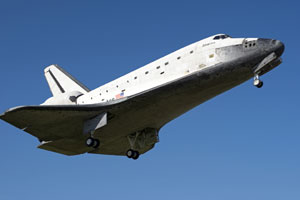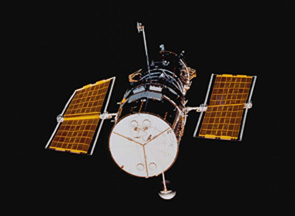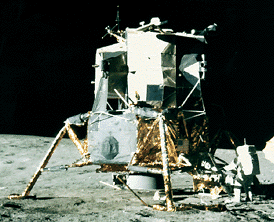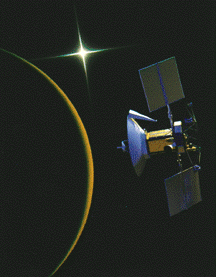Image of Magellan orbiting Venus.
Click on image for full size
NASA/JPL
Magellan
On May 4, 1989, Magellan, a spacecraft built mostly from spare parts from other missions, was carried into Earth orbit by the Atlantis space shuttle and launched toward Venus. It arrived on Aug. 10, 1990 and inserted itself into a highly elliptical polarorbit.
Over the next 3 years, Magellan used radar to penetrate the dense cloud cover surrounding Venus and map its surface. With every orbit it sent back strips of data, which were assimilated by scientists back on Earth into a 98% complete global map. Because Magellan viewed the Venusian surface from varying angles, 3-dimensional images of the planet's terrain were also possible.
After studying Venus' gravitational field for a year, Magellan then plunged into its atmosphere, testing a new technique for controlling surface descent, called aerobraking. Aerobraking involves dipping a spacecraft's orbit through a planet's atmosphere, thus creating friction which slows it down and results in a more energy-efficient descent. Although Magellan was crushed by the Venus' pressure before reaching the surface, scientists obtained valuable information that would make aerobraking useful in future missions.
You might also be interested in:

Radar is short for "radio detection and ranging". A transmitter emits pulses of high frequency electromagnetic waves (radio waves). These waves strike conductive objects and are backscattered to the receiver.
...more
Venus is one of the brightest objects in the sky, so it is clearly visible to the naked eye. It can be tricky to spot, however, because it is always near the Sun. Because of this, it rises and sets with
...more
The space shuttle Atlantis completed its final scheduled flight when it touched down on at Kennedy Space Center on the morning of May 26, 2010. NASA is planning to retire the entire fleet of space shuttle
...more
The Hubble Space Telescope (HST) was one of the most important exploration tools of the past two decades, and will continue to serve as a great resource well into the new millennium. The HST is credited
...more
Driven by a recent surge in space research, the Apollo program hoped to add to the accomplishments of the Lunar Orbiter and Surveyor missions of the late 1960's. Apollo 11 was the first mission to succeed
...more
Apollo 12 survived a lightning strike during its launch on Nov. 14, 1969, and arrived at the Moon three days later. Astronauts Charles Conrad and Alan Bean descended to the surface, while Richard Gordon
...more
Apollo 15 marked the start of a new series of missions from the Apollo space program, each capable of exploring more lunar terrain than ever before. Launched on July 26, 1971, Apollo 15 reached the Moon
...more















